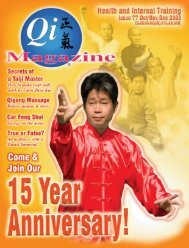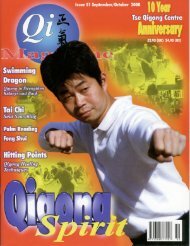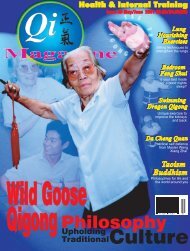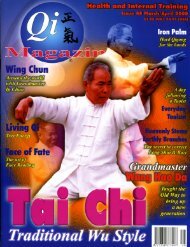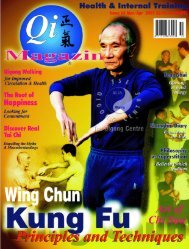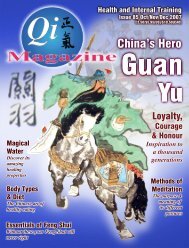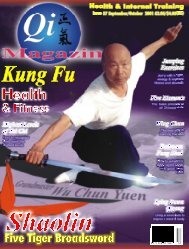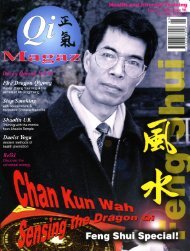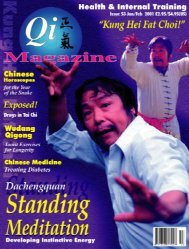Issue 49 - Tse Qigong Centre
Issue 49 - Tse Qigong Centre
Issue 49 - Tse Qigong Centre
- No tags were found...
Create successful ePaper yourself
Turn your PDF publications into a flip-book with our unique Google optimized e-Paper software.
Last time we looked at the <strong>Centre</strong>line and found that there werein fact three <strong>Centre</strong>lines to consider, the Jik Sin (<strong>Centre</strong> Line), Ji NgSin (Meridian Line) and the <strong>Centre</strong> of Gravity. Now we will look athow <strong>Centre</strong>line theory is commonly misunderstood.The <strong>Centre</strong> LinePart 2: MisconceptionsSomeone once made a passingcomment about Wing Chun. It wentsomething like, “Wing Chun onlyblocks attacks that come in along thecentreline”. This statement implies thatunless your opponent attacks you alongthe centreline then you will not botherdefending yourself against this attack. Sofor example, if your opponent were toattack you with a hooking, circular punch,then you would not bother to block them.This is of course nonsense. Who will allowsomeone to hit them just because theyattack you in a different way?If you are in a situation where youropponent uses a very long circular punch,then so long as you are quick enough,you can step in along the meridian lineand strike first. Although his arm may hityou, his power is focused at his fist andso you will avoid this. Also if your punchis good enough, you will disturb hisbalance and so he will be furtherweakened. This however, will only workwhen he is preparing to throw the punchor the punch is just beginning. As yousee him preparing to punch you counterattack. Is this blocking or just reading thesituation well?However, not all swingingpunches are so long. For example, acommon hook punch is a compact punch,is very powerful and used at quite closerange. In order to prevent this punch fromhitting you, you need to meet the insideof your opponent’s arm. This helped byturning your stance (so your shouldersface more towards the punch) and thiswill give your defending technique muchmore leverage and so you will not berelying on the strength of your arm butusing your entire body together. At thesame time you can attack back by strikingat your opponent along the Ji Ng Sin.In order to become accustomedto defending against circular attacks thenyou should practise with someone untilyou feel comfortable with how the attacksmove and work. Stepping and turningyour stance will giveA Byou more leverageand so you can useless energy.When attacking,you shouldattack along the JiNg Sin. This brings usto another commonmistake. As we havealready seen, whenyour opponent isdirectly opposite andfacing you, youshould strike directlytowards his Jik Sin orfor example his nose.If you were to turnand punch you willbe correct inpunching towards hisnose. When you havean opponent this isquite obvious.However, whenpractising alone, infront of a mirrorerrors can arise.When standingsquare on to themirror you punchtowards your ownnose. If however youturned your stanceand punched, thenyou should no longerbe punching towardsthe reflection of yournose. Why is this?Turning yourstance will actuallymove your Jik Sinand so change the JiNg Sin (as of coursewill stepping). Whenyou turn your stance 45 degrees, forexample to your right, your Jik Sin willalso move to the right. This is becauseyour weight shifts over to the right andyour head also moves to theright. However, in this exercise,your imaginary opponent hasnot moved and so you shouldpunch to where your nose usedto be, not at where you see itin the mirror after you haveturned. If you continue topunch towards your nose afteryou have turned, then you aremissing your target. It helps ifLine B marks Grandmaster IpChun’s Jik Sin (<strong>Centre</strong> line)after he has turned his stance.Line A repreasent his Jik Sinbefore he turned and punched.If he were facing a mirror andaimed his punch at the reflectionof his nose he would not beaiming at the correct place. Youcan see this from the drawingsbelow.you draw a vertical line downthe mirror and then use this asyour opponent’s Jik Sin. Nowyou should punch along the JiNg Sin towards the line on themirror. In the old days, WingChun practitioners did nothave mirrors and so wouldplace a stick vertically in theground and use this forreference. This way they alwaysknew where their target was.The same principle isalso true when practisingdefensive techniques in front ofa mirror.If this all seems verycomplicated, don’t worry,unlike most things wheresaying is easier than doing, thisis a case of doing is easier than saying.Try it for yourself and seeby Darryl Moyemail Darryl@qimagazine.comWing Chun KuenQi Magazine 13



